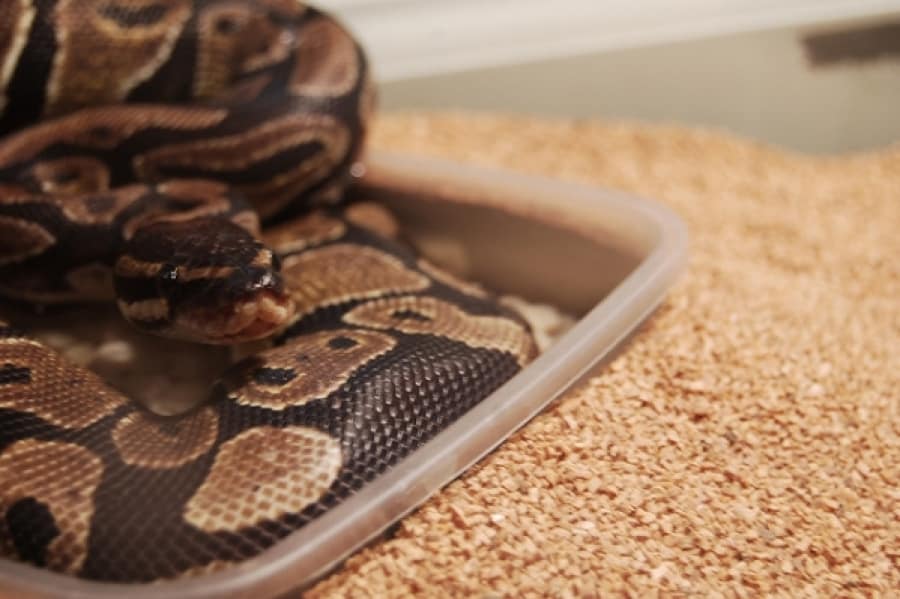
Scientific Name
- The scientific name of Ball Python is Python regius.
Description
- The Ball Python is also known as the Royal Python though this is more common in European countries.
- The “Royal” name was brought about in part by Cleopatra, who reportedly wore these beautiful snakes as bracelets on her wrists.
- The origin of the “Ball” name derives from their natural defense mechanism that when stressed, they will curl into a tight ball with their heads hidden inside and not move for long periods of time.
- The Ball Python is an attractive snake with a dark, brown-black pattern and yellow-tan skin.
- This species of snake is very curious and gentle in nature.
- These traits, as well as the inexpensive price, make it a popular reptile pet.
- Ball Pythons make excellent pets.
- Their inexpensive price, good temperament, and long life spans make them one of the top-selling snakes.
- The short but stout size makes them very impressive in stature.
- The key to keeping these animals healthy is in their care.
- In recent years, captive breeding projects have developed several interesting color varieties which all share the same care guidelines.
Distribution
- Ball Pythons are native to Central and Western Africa and are ‘crepuscular’, being most active at dusk and dawn.
Breeding
- Sexing a Ball Python is relatively easy.
- Like all pythons and boas, they have anal spurs.
- These claw-like structures are about 2 – 3 inches from the tip of the tail.
- Males have longer spurs than females. The spurs are thought to be evolutionary remnants of hind legs.
- Males also tend to have smaller heads than females.
- Mating usually requires a mild cooling or partial hibernation period.
- The average clutch size is 4 – 10 eggs, and the average incubation period is 90 days.
- The female will protect the eggs from the moment they are laid until they hatch.
- During this time, she does not eat and can become highly irritable and stressed.
- For this reason, artificial incubation in captivity is usually recommended.
- To accomplish this, maintain a plastic container with damp sphagnum moss in the cage while the female is gravid. The female will usually lay the eggs in this container.
- After the eggs are laid, remove the eggs and moss and place them in moist (not wet) vermiculite for incubation. Bury the eggs with the tops showing.
- It can take hours or even days for the young to fully emerge from their egg.
- House the hatchlings individually once the shell is broken, and be patient.
- Young Ball Pythons usually grow about a foot a year for the first three years.
Snake Housing for Ball Python
- Ball Pythons should be housed in cages measuring 36″ x 18″ x 16″ or larger, roughly a 40-gallon aquarium size.
- As for juveniles or hatchlings, a 10 – 20 gallon aquarium will suffice.
- Always make sure the cage is secure, as these Ball Pythons are very powerful and cunning when it comes to escaping.
- A beginning substrate should be the newspaper.
- This will allow you to check for parasites and observe the feces for problems.
- After the snake is established and eating well, you can use cypress or fir bark as a substrate.
- Avoid using pine or cedar shavings since their oils have been associated with respiratory problems.
- Washable, reusable reptile ‘carpets’ can also be used.
- All types of substrates must be cleaned or replaced whenever soiled to avoid fungal or bacterial growth.
- Same as other snakes, a hiding place is a must.
- You can use anything from cardboard boxes to hollow logs to manufactured reptile houses.
- The hiding place should be large enough for the snake’s entire body.
- Snug or tight enclosures are preferred for sleeping and security senses.
- Don’t forget to put a climbing branch in the tank, as Ball Pythons love to climb.
- Ball Python should be kept at 82ºF at the cool end and 86ºF at the hot spot.
- The temperature can be safely lowered to 70ºF at night.
- A variety of heating methods, such as; under-the-tank heating pads, specialty reptile heat/light bulbs, ceramic bulbs, etc, can be used.
- A thermometer to test the temperature and check the heating devices from time to time is recommended.
- This species is vulnerable to thermal burns, so direct contact with the heat source should be prevented.
- Always provide a fresh bowl of water that is replaced daily. Ball Pythons will occasionally soak in the bowl to help with the shedding process.
- This can cause overspills if the bowl is too small.
Size
- These snakes can achieve length to an average adult size of about 4ft (1.2 meters), but occasional specimens have been known to reach 5ft (1.5 meters)
Life Span
- Ball Python has a long lifespan of up to 30 years, with the oldest recorded specimen having lived 48 years.
Diet
- In the wild, the Ball Python will eat a variety of prey, including lizards, birds, and small mammals.
- Wild-caught specimens are often associated with difficulty in getting them to accept ‘lab mice’ in captivity. You can trick the snake by rubbing a chick on the mouse or by putting a shed lizard skin on it.
- Then slowly switch the python over to mice. Buy a captive-bred snake to reduce potential problems.
- Ball Pythons have a reputation for going for long periods of time without food. Specimens have been known to go a year or more without feeding, but this is not common or safe practice.
- Long fasting periods can seriously weaken the snake and open it to disease.
- For best results, feed every 2-4 weeks, and seek veterinary advice for fast periods longer than one month to ensure internal parasites or other health issues are not involved.
- For best results, food should be lightly dusted in a calcium or nutritional supplement such as Tetra’s ReptoCal or ReptoLife Plus.
Habitat
- They tend to be found in grasslands or on the edge of the forests.
- Mostly ground-oriented snakes, they are known to be semi-arboreal.
Common Disease
- Wild-caught specimens can frequently have internal parasites.
- If your pet becomes sluggish, refuses to eat for several weeks, has been discharged from the nose/mouth, or regurgitates meals, seek a veterinarian for help.
- Ask your vet, but feces samples are often helpful in properly diagnosing and treating your pet.
